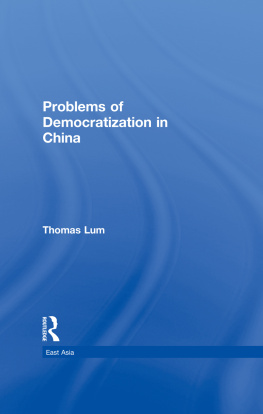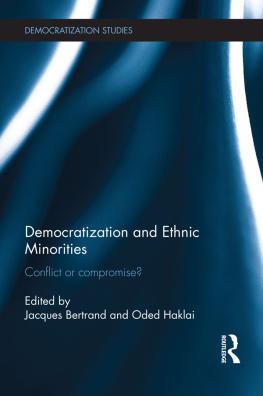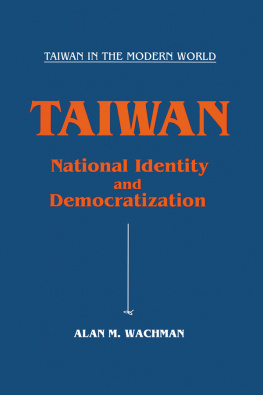Strategies of Democratization
Strategies of Democratization
Edited by
Tatu Vanhanen
University of Tampere, Finland
Published by Taylor & Francis
270 Madison Ave, New York NY 10016
2 Park Square, Milton Park, Abingdon, Oxon, OX14 4RN
Transferred to Digital Printing 2010
STRATEGIES OF DEMOCRATIZATION
Copyright 1992 by Taylor & Francis. All rights reserved. Printed in the United States of America. Except as permitted under the United States Copyright Act of 1976, no part of this publication may be reproduced or distributed in any form or by any means, or stored in a database or retrieval system, without the prior written permission of the publisher.
1 2 3 4 5 6 7 8 9 0B R B R9 8 7 6 5 4 3 2
This book was set in Times Roman by Hemisphere Publishing Corporation. The editors were Radhika Rao Gupta and Susan Connell; the production supervisor was Peggy M. Rote; and the typesetter was Wayne Hutchins. Cover design by Michelle Fleitz. Printing and binding by Braun Brumfield Inc.
A CIP catalog record for this book is available from the British Library.
The paper in this publication meets the requirements of the ANSI Standard Z39.48-1984(Permanence of Paper)
Library of Congress Cataloging-in-Publication Data
Strategies of democratization / edited by Tatu Vanhanen.
p. cm.
Includes bibliographical references and index.
1. DemocracyHistory20th century. 2. Political planning
History20th century.3. World politics1989-I. Vanhanen
Tatu.
JC42l.S77 1992
321.80904-dc20
92-7940
ISBN 0-8448-1719-8 (case)
CIP
ISBN 0-8448-1720-1 (paper)
Publisher's Note
The publisher has gone to great lengths to ensure the quality of this reprint but points out that some imperfections in the original may be apparent
To my colleagues in the IPSA
Study Group 32:Democratization
in Comparative Perspective
Contents
Preface
Democratization has been spreading like brush fire since the 1980s, breaking barriers and gaining foothold in new territories, although not with equal success in all parts of the world. There are still regions and countries dominated by hegemonic political systems, and all established democracies have not survived in the incessant struggle for power within societies. It is evident that the variation in environmental conditions is related to the success of democratization, but one can assume that the strategies of political leadership and other political actors also matter. The purpose of this book is to examine the strategies used in the struggle for democracy and the problems of democratization in different parts of the world. This examination is based on the idea that the conscious choices of people and their leaders matter and that better knowledge of successful and unsuccessful strategies might help people to adopt more rational strategies in the struggle for democracy.
This book originated in the international cooperation of political scientists interested in the problems of democratization. The International Political Science Association's Study Group 32: Democratization in Comparative Perspective, established in 1989, provided an organizational background for this cooperation. The contributors of this book are members of that study group, and several of them participated in the first meeting of the study group at the Department of Political Science and International Relations, University of Tampere, Finland, May 14-17, 1990.
Kwang Woon Kim's, Mt Szabs, and Brantly Womack's articles are revised versions of their papers presented at the first meeting of the IPSA Study Group 32 in May 1990. Erik N. Komarov and Tatu Vanhanen presented papers at the same meeting, but their articles published in this book are different ones. Komarov's chapter on the emergence of a multiparty system in the Soviet Union is taken from his unfinished book manuscript Democratization and Emergence of a Multiparty System in the Soviet Union: An Outline. Fanie Cloete's article is an abbreviated version of his paper presented at the XV World Congress of IPSA in Buenos Aires, on 21-25 July 1991, and later published in Africa Insight 21(4), 1991. Samuel Decalo's and Vuina Vasovis papers as well as the paper by Marlene M. Miguel and Michael J. Berland, were presented at the XII World Conference of the World Futures Studies Federation on Advancing Democracy and Participation, in Barcelona, Spain on 1721 September 1991.
I am grateful to the Academy of Finland for a research grant, which was used for the checking of English of the manuscript; to The English Centre, Helsinki, which checked the English of most chapters; and to Leila Ojanen, University of Tampere, who checked some other parts of the manuscript. My special thanks are due to Dr. Ralph H. Salmi, Editor of Political Science and International Relations, Taylor & Francis, for his valuable advice and support, and to Todd W. Baldwin, Acquisitions Editor, and Susan Connell, Production Editor, who facilitated the publication of this book.
Tatu Vanhanen
Tampere, Finland
Chapter 1
Introduction
Tatu Vanhanen
This book deals with strategies of democratization. The idea is to explore the scope and significance of human choices in the process of democratization and to produce knowledge that might help to overcome various obstacles in the path of democratization. What kinds of strategies might most effectively further attempts to democratize political systems and to consolidate democratic institutions? Two major approaches are taken to the problem; the first approach is the more theoretical of the two. It poses the question of the relative significance of social and other environmental constraints versus conscious strategies of democratization. Is democratization a more or less unintended consequence of change in social conditions and other environmental factors, or is it rather a result of the conscious efforts of political actors to change a country's political system? To what extent might it be possible to further or hamper democratization by conscious political and social strategies, and what should those strategies be? The second approach highlights particular countries and regions in which the struggle for democracy is actually taking place. Attention is devoted to actual strategies used in the struggle for democracy in various countries and under different local conditions. What strategies have actually been used in the process of democratization? How can we explain successful and failed attempts to democratize political systems? Have the strategies been rational and effective, or have they been faulty and mistaken? Which strategies have been successful and which have failed? To what extent has the success or failure in a particular case been due to social conditions and to political strategies used in the struggle for democratization? The chapters dealing with particular countries and regions illustrate the actual strategies used in the struggle for democracy in various parts of the world and in widely different social and political circumstances. The two approaches are intended to complement each other. General arguments and hypotheses provide a framework for detailed analyses of particular countries, whereas the latter offer empirical data that can be used to test our general arguments and hypotheses.
COMPARATIVE STUDIES OF DEMOCRATIZATION














